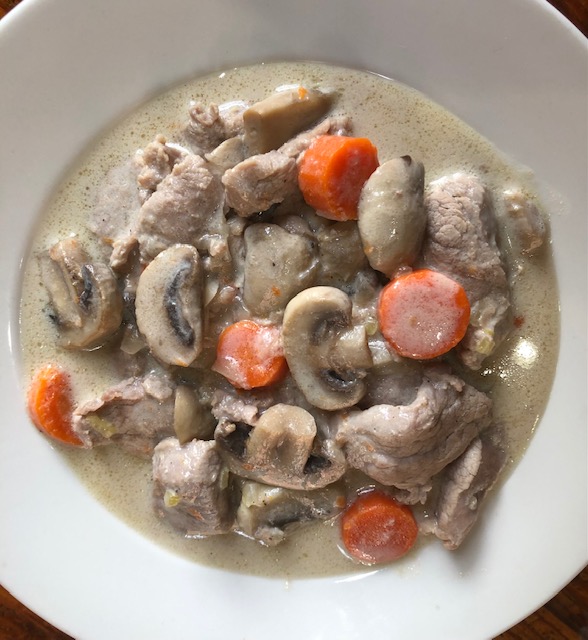Blanquette is a classical French white stew popular in past centuries. It’s an example of “Cuisine Bourgeoise,” the fancy home cooking of the French Middle Class, rather than either a high-end restaurant dish (“Haute Cuisine”) or a provincial staple of the peasantry or urban poor. Literally indicating a dish containing a white meat in a white sauce, blanquette in France was traditionally made with veal, although there were also less prestigious pork and chicken versions. Nowadays, veal is expensive, not particularly good in the US (in my view), and is increasingly frowned upon because of the treatment of calves in producing veal. Although I haven’t tried it in a blanquette, turkey breast or breast tender is often substituted for veal in Europe.
Here is my version of blanquette using pork, in French “Blanquette de Porc.” At our restaurant, a customer who has strong Louisiana ties frequently requests that we make this dish, which we sell frozen in quarts. He likes to serve Louisiana and French and Créole food when he entertains. I just made a moderately large batch today at his request, and got it quarted and into the freezer for him to have around the New Year holiday.Pork tenderloin, a favorite of mine, is relatively easy to
cook with and it is often sold quite cheaply at warehouse clubs and
supermarkets. It’s almost entirely edible, tender and moist, needs little
trimming and has decent, if somewhat mild flavor. I have trouble believing how
cheap it often is. It must be that people don’t know how to cook with it. Other,
to me inferior, cuts like shoulder steaks, loin and pork chops often get higher
prices.
Blanquette was originally a creation from Normandy, so a potato dish would be a more conventional accompaniment than rice or noodle dishes from the south of France. But those latter can work too. Baguette or toasted bread also goes well. My preference for a pairing wine would be a relatively full-bodied white, such as an unoaked Chardonnay or Viognier, and not a red or rosé.
The recipe will make about two quarts, and will serve six to eight people.
2 large carrots, peeled and sliced 1/2-inch wide
1/2 pound mushrooms, tip of stem cut off and top sliced 1/2-inch wide
1 small onion, finely diced
4-inch piece of celery finely diced
1 small clove garlic minced
1 slice raw bacon, finely minced
2 pounds pork tenderloin
2 tablespoons cornstarch
1 teaspoon salt for the meat plus more for cooking
1/4 teaspoon black pepper for the meat plus 1/4 teaspoon for
cooking
1/8 teaspoon nutmeg
4 tablespoons white wine
3 tablespoons olive oil, plus more as needed
2 cups chicken broth, low or non-salt
1 large bay leaf
1 cup sour cream
Prepare the carrots and mushrooms and set aside. Dice or mince the other three vegetables and bacon and set aside. (The dicing/mincing can be done by hand, or the onion, celery, garlic and bacon can be finely chopped, but not pureed, together in a food processor).
Trim any fibrous “silver skin” and excess fat from the meat. Split each tenderloin lengthwise down the middle. Cut the pieces crosswise into 1/2-inch thick slices. Mix well with the cornstarch, salt, black pepper, nutmeg and white wine.Heat oil in a heavy pot over high heat. Cook the marinated pork, stirring frequently and scraping the bottom of the pot, until meat has fully changed color. Remove it to a bowl and scrape in any juices.
Add several tablespoons more oil to the pot and cook in the onion, celery, garlic and bacon, stirring very frequently, until becoming tender. Add the chicken broth, bay leaf, 1/2 teaspoon salt and 1/4 teaspoon pepper. Simmer, covered, five minutes. Add sliced carrots and mushrooms and simmer, covered, stirring from time to time, until carrot is nearly tender.
Add the pre-cooked pork, bring to a boil and cook five minutes. Add sour cream, stir in and bring just back to a boil. Remove from the heat. Stir well, and taste for salt. Add some as needed. Remove the bay leaf.
The stew can be served now or cooled and reheated to serve later.





.jpg)
.jpg)

